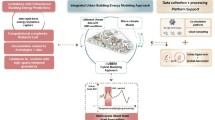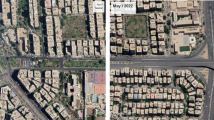Abstract
This study investigates the potential of contemporary Earth-Sheltered Buildings to contribute to sustainable societies by achieving Plus Energy Building status during the heating season. The buildings analyzed are intended to house a four-member family (102.5 m2). The house is equipped with a ground source heat pump, geothermal vertical probes, floor heating panels, an energy recovery ventilator, and building-integrated photovoltaic panels installed on the exposed building wall. The numerical analysis (using EnergyPlus software) was carried out for nine European sites covering five different climatic zones (namely: southern, Atlantic, continental, alpine, and northern climate) and three latitude belts spanning Europe from south to north. Buildings above 65° N (northern and alpine climate) could not achieve Plus Energy status with 20% efficient BIPVs. With 15% efficient BIPVs, the building above 59° N (northern climate) was incapable of achieving this as well. Regarding the monthly time step, the buildings in the southern and Atlantic climates with 15% efficient BIPVs were able to produce an energy surplus every month, as was the building in the Alps with 20% efficient BIPVs.
Similar content being viewed by others
Abbreviations
- A :
-
area [m2]
- COP:
-
coefficient of performance [—]
- d :
-
thickness [m]
- E :
-
electricity production and consumption [kWh]
- el :
-
elevation [m]
- f :
-
fraction [—]
- HDD:
-
heating degree days [°C·d]
- I :
-
solar radiation [kWh/m2]
- k :
-
thermal conductivity [W/(m·K)]
- Δp :
-
pressure drop [Pa]
- R :
-
heat resistance [m2·K/W]
- T :
-
absolute temperature [K]
- TZ :
-
time zone [h]
- U :
-
heat transfer coefficient [W/(m2·K)]
- V :
-
volume flow [m3/s]
- η :
-
efficiency [—]
- λ :
-
longitude [°]
- ρ :
-
density [kg/m3]
- τ :
-
time [h]
- φ :
-
latitude [°]
- *:
-
correction
- 1:
-
inlet
- 2:
-
outlet
- a:
-
exhaust from the thermal zone
- b:
-
supply to the thermal zone
- CR:
-
circumsolar region
- DIFF:
-
diffuse
- DIR:
-
direct
- FAN:
-
fan
- G:
-
ground
- INV:
-
inverter
- LAT:
-
latent
- O:
-
obstacle
- REFL:
-
reflection
- SD:
-
skydome
- SENS:
-
sensible
- SH:
-
sky horizon
- TOT:
-
total
- BAT:
-
bathroom
- BDR:
-
bedroom
- BIPV:
-
building-integrated photovoltaic
- ERV:
-
energy recovery ventilation
- EHS:
-
end of a heating season
- ES:
-
earth-sheltered
- ESB:
-
earth-sheltered buildings
- FHP:
-
floor heating panels
- GSHP:
-
ground source heat pump
- GVP:
-
geothermal vertical probes
- H:
-
hall
- IPCC:
-
Intergovernmental Panel on Climate Change
- K:
-
kitchen
- LR:
-
living room
- PEB:
-
Plus Energy Building
- PV:
-
photovoltaic
- SR:
-
storage room
- SHS:
-
start of a heating season
- SUB:
-
semi-underground buildings
- Z :
-
thermal zone (room)
References
Akubue J (2021). Earth sheltered housing; design concepts for urban ground-scrapers. International Journal of Architecture, Arts and Applications, 7: 1–7.
Androutsopoulos A, Giakoumi A (2020). Implementation of the EPBD Greece—Status in 2020.
AUTH (2015). Soil Map of Greece. Aristotle University of Thessaloniki (AUTH). Available at http://appliedsoilab.web.auth.gr/images/GRSoilMap_ENG_500k_poster_oversize_May2016_v2_300dpi.pdf.
Baumgarten A, Haslmayr HP, Schwarz M, et al. (2021). Organic soil carbon in Austria—Status quo and foreseeable trends. Geoderma, 402: 115214.
Callejas IJA, Durante LC, da Guarda ELA, et al. (2020). Thermal Performance of Partially Bermed Earth-Sheltered House: Measure for Adapting to Climate Change in a Tropical Climate Region. In: Proceedings of the First World Energies Forum—Current and Future Energy Issues.
Cao Y (2012). The renovation of traditional cave housing in China: New ecological design for old yaodong. Master Thesis, Politecnico di Milano, Italy.
Deslot Q, Pache Y, Cartier Da Costa I, et al. (2020). Implementation of the EPBD in France—Status in 2020.
Dieter T (2017). Europe. In: Wainwright G, McPartlan P (eds), The Oxford Handbook of Ecumenical Studies. London: Oxford University Press. pp. 545–558.
EnergyPlus (2016). EnergyPlus Engineering Reference. The board of US Department of Energy (DOE).
Eskilson P (1987). Thermal analysis of heat extraction boreholes. PhD Thesis, University of Lund, Sweden.
Food and Agriculture Organization of the United Nations (2003). Fertilizer Use by Crop in Poland, Chapter 1. Available at https://www.fao.org/3/y4620e/y4620e05.htm. Accessed 14 May 2023.
Giama E, Papadopoulos AM (2012). Sustainable building management: Overview of certification schemes and standards. Advances in Building Energy Research, 6: 242–258.
Gocke MI, Don A, Heidkamp A, et al. (2021). The phosphorus status of German cropland—An inventory of top- and subsoils. Journal of Plant Nutrition and Soil Science, 184: 51–64.
Gordic D, Nikolic J, Vukasinovic V, et al. (2023). Offsetting carbon emissions from household electricity consumption in Europe. Renewable and Sustainable Energy Reviews, 175: 113154.
Hawila AAW, Pernetti R, Pozza C, et al. (2022). Plus energy building: Operational definition and assessment. Energy and Buildings, 265: 112069.
Horward A-C, Rosenberger J (2020). Implementation of the EPBD Germany—Status in 2020.
Hubbard SS, Schmutz M, Balde A, et al. (2021). Estimation of soil classes and their relationship to grapevine vigor in a Bordeaux vineyard: Advancing the practical joint use of electromagnetic induction (EMI) and NDVI datasets for precision viticulture. Precision Agriculture, 22: 1353–1376.
Huynh A, Barkokebas RD, Al-Hussein M, et al. (2021). Energy-efficiency requirements for residential building envelopes in cold-climate regions. Atmosphere, 12: 405.
Jideofor A (2012). Earth shelters; A review of energy conservation properties in earth sheltered housing. In: Anselm AJ (ed), Energy Conservation. London: IntechOpen.
Kaczorek D, Bekierski D (2020). Implementation of the EPBD in Poland—Status in 2020.
Khaksar A, Tabadkani A, Mofidi Shemirani SM, et al. (2022). Thermal comfort analysis of earth-sheltered buildings: The case of meymand village, Iran. Frontiers of Architectural Research, 11: 1214–1238.
Lazović Đ, Džodić K, Đurišić Ž (2021). Analysis of economic justification of investing in a solar power plant with vertically placed bifacial photovoltaic modules in perspective of free market conditions. Energija, Ekonomija, Ekologija, 23(3): 37–44.
Logan L, Andersson JBH, Whitehouse MJ, et al. (2022). Energy drive for the Kiruna mining district mineral system(s): insights from U-Pb zircon geochronology. Minerals, 12: 875.
Man Y, Yang H, Wang J, et al. (2011). Operation performance investigation of ground-coupled heat-pump system for temperate region. International Journal of Low-Carbon Technologies, 6: 107–118.
Márquez JMA, Bohórquez MÁM, Melgar SG (2016). Ground thermal diffusivity calculation by direct soil temperature measurement. application to very low enthalpy geothermal energy systems. Sensors, 16: 306.
Metzger MJ, Bunce RGH, Jongman RHG, et al. (2005). A climatic stratification of the environment of Europe. Global Ecology and Biogeography, 14: 549–563.
Metzger MJ (2018). Sub-regional classification of the IPCC Europe region. The University of Edinburgh. Available at https://datashare.ed.ac.uk/handle/10283/3158?show=full. Accessed 16 Aug 2022.
Milanović AR, Folić NK, Folić R (2018). Earth-sheltered house: A case study of dobraca village house near kragujevac, Serbia. Sustainability, 10: 3629.
Ministry of Agriculture (2012). Minimum requirements for energy performance. Availabe at https://www.riigiteataja.ee/en/eli/520102014001/consolide. Accessed 10 Nov 2022.
Ministry of Construction Transport and Infrastructure (2011). Rulebook of energy efficiency. Official Gazette of the Republic of Serbia 61/2011.
Nešović A (2022). Theoretical model of solar incident angle for an optionally oriented fixed flat surf ace. Tehnika, 77: 328–333. (in Serbian)
NREL (2015). Engineering Reference—The Reference to EnergyPlus Calculations. Golden, CO, USA: National Renewable Energy Laboratory (NREL).
Porras-Amores C, Mazarrón FR, Cañas I, et al. (2019). Natural ventilation analysis in an underground construction: CFD simulation and experimental validation. Tunnelling and Underground Space Technology, 90: 162–173.
Reintam L, Rooma I, Kull A (1999). Map of soil vulnerability and degradation in Estonia. In: Stott DE, Mohtar RH, Steinhardt GC (eds), Sustaining the Global Farm. Selected papers from the 10th international soil conservation organization meeting, pp. 1068–1074.
Rousselot M, Pinto Da Rocha F (2021). Energy efficiency trends in buildings in the EU. ODYSSEE-MURE Policy brief (June).
Roy R (2006). The Complete Book of Underground Houses, How to Build a Low-Cost Home. Gabriola Island, Canada: New Society Publishers.
Seinre E, Kurnitski J, Kuusk K, et al. (2020). Implementation of the EPBD Estonia—Status in 2020.
Serbian Environmental Protection Agency (2015). Danube Basin eSOTER Soil Database.
Šijaković M, Perić A (2020). Sustainable architectural design: Towards climate change mitigation. Archnet-IJAR, 15: 385–400.
Stadler R, Thoma W (2020). Implementation of the EPBD in Austria—Status in November 2020.
Stolbovoi V (2000). Soils of Russia: Correlated with the revised legend of the FAO soil map of the world and world reference base for soil resources. Working Papers ir98037, International Institute for Applied Systems Analysis.
Ürge-Vorsatz D, Cabeza LF, Serrano S, et al. (2015). Heating and cooling energy trends and drivers in buildings. Renewable and Sustainable Energy Reviews, 41: 85–98.
Van Dronkelaar C, Cóstola D, Mangkuto RA, et al. (2014). Heating and cooling energy demand in underground buildings: potential for saving in various climates and functions. Energy and Buildings, 71: 129–136.
Weather Atlas (n.d.). Global Weather forecast and Climate information. Available at https://www.weather-atlas.com/. Accessed 18 Aug 2022.
WorldData (n.d.). Energy consumption in Russia. Availabke at https://www.worlddata.info/europe/russia/energyconsumption.php. Accessed 19 April 2023.
Yavuzturk C, Spitler JD (1999). A short time step response factor model for vertical ground loop heat exchangers. ASHRAE Transactions, 105(2): 475–485.
Yavuzturk C, Spitler JD (2001). Field validation of a short time step model for vertical ground-loop heat exchangers. ASHRAE Transactions, 107(1): 616–625.
Zhao J, Peng F, Wang T, et al. (2016). Advances in master planning of urban underground space (UUS) in China. Tunnelling and Underground Space Technology, 55: 290–307.
Author information
Authors and Affiliations
Contributions
All authors contributed to the study conception and design. Material preparation, data collection and analysis were performed by Aleksandar Nešović, Nebojša Jurišević, Robert Kowalik, Ivana Terzić. The first draft of the manuscript was written by Nebojša Jurišević and Aleksandar Nešović, and all authors commented on previous versions of the manuscript. All authors read and approved the final manuscript.
Corresponding author
Ethics declarations
Declaration of competing interest
The authors have no competing interests to declare that are relevant to the content of this article.
Ethical approval
This study does not contain any studies with human or animal subjects performed by any of the authors.
Rights and permissions
About this article
Cite this article
Nešović, A., Jurišević, N., Kowalik, R. et al. Potential of contemporary earth-sheltered buildings to achieve Plus Energy status in various European climates during the heating season. Build. Simul. 17, 41–52 (2024). https://doi.org/10.1007/s12273-023-1061-x
Received:
Revised:
Accepted:
Published:
Issue Date:
DOI: https://doi.org/10.1007/s12273-023-1061-x




